| Pages:
1
2 |
The WiZard is In
International Hazard
    
Posts: 1617
Registered: 3-4-2010
Member Is Offline
Mood: No Mood
|
|
Quote: Originally posted by Magpie  | Thank you. In the ANSI/ASME B31.1 table A106 Grade B Carbon Steel Pipes – Pressure and Temperature Ratings - the maximum allowable pressure for
2.5” pipe was interpolated between that for 2” and 3” pipe at 400F to be 2485 psi.
I did not test the autoclave to destruction so we have to go with the calculated value. Using a safety factor of 2 an upper limit would be:
2485psi/2 = 1243 psi = 84.5atm at 400F (205C). If a higher temperature is used the maximum safe operating pressure would have to be de-rated
accordingly.
Keep in mind that this is not my field of expertise. |
I would think of replacing the bolts/nuts periodically. While the
internal pressure is trivial... depending on how high a toque
value you use when you tighten the bolts/nuts - the bolts will
stretch/weaken. When gas/diesel engines are taken down
the head bolts are never reused only replaced, and this is after
one use. Constantly removing/replacing your bolts put a lot
of strain on them. No doubt there is mechanical engineering
info on this out there somewhere.
Oh and by da - have you considered a safety pressure relief valve?
|
|
|
Magpie
lab constructor
    
Posts: 5939
Registered: 1-11-2003
Location: USA
Member Is Offline
Mood: Chemistry: the subtle science.
|
|
Quote: Originally posted by The WiZard is In  |
I would think of replacing the bolts/nuts periodically. While the
internal pressure is trivial... depending on how high a toque
value you use when you tighten the bolts/nuts - the bolts will
stretch/weaken. When gas/diesel engines are taken down
the head bolts are never reused only replaced, and this is after
one use. Constantly removing/replacing your bolts put a lot
of strain on them. No doubt there is mechanical engineering
info on this out there somewhere.
Oh and by da - have you considered a safety pressure relief valve?
|
Thanks for the tip about the bolts. I've probably reused them about 5 times, mostly during shake-down. Originally I was torquing to 100 ft-lbs but
ended up only using 80 ft-lbs.
I did plan to use a safety relief valve. It would replace the fill port plug. I had actually found a good one for under $100, but never bought it.
The main reason being that the plug was sealing and I was concerned that a new male thread device might not seal. As indicated, I had a lot of
trouble getting the threaded connections to seal.
The single most important condition for a successful synthesis is good mixing - Nicodem
|
|
|
bobm4360
Hazard to Self
 
Posts: 59
Registered: 18-4-2011
Location: On a wretched little island.
Member Is Offline
Mood: No Mood
|
|
Regarding bolt life-
An easy check is, if on opening, one of the nuts is significantly easier to break loose, then it's time to replace all fasteners
Exceeding the yield strength of three-quarter inch studs is not easy.........
Regards,
Bob
|
|
|
The WiZard is In
International Hazard
    
Posts: 1617
Registered: 3-4-2010
Member Is Offline
Mood: No Mood
|
|
My 60-ton hollow core hydraulic cylinder does it with a
snap. If not I also own a 100-ton one. Any who - bolts are
torqued to "50-60% of the fracture torque... The tension in a bolt
tightened using this procedure will be about 60 - 70 per cent of the
elastic limit (yield strength) of the bolt material."
Now this do be for the bolts first use ... after the 2 -3rd use....
the bolt has been stretched and has lost a lot of strength.
This is why in critical application the bolts are only used once.
Speaking upon bolts - was watching some TV pgm. they were
installing a really large diesel engine in a ship. The bolts
used to hold the engine to its mounts were first
cooled in LN2 so they would fit into the holes. Any vibration
by an engine that large would in short time rip the
engine free/sink the ship.
Trivia - During WWII when the American Army shipped
RR locomotives to Burma ... the cribbing used shipboard
was - lead blocks.
|
|
|
Magpie
lab constructor
    
Posts: 5939
Registered: 1-11-2003
Location: USA
Member Is Offline
Mood: Chemistry: the subtle science.
|
|
Quote: Originally posted by The WiZard is In  |
I would think of replacing the bolts/nuts periodically. While the
internal pressure is trivial... depending on how high a toque
value you use when you tighten the bolts/nuts - the bolts will
stretch/weaken. When gas/diesel engines are taken down
the head bolts are never reused only replaced, and this is after
one use. Constantly removing/replacing your bolts put a lot
of strain on them. No doubt there is mechanical engineering
info on this out there somewhere.
|
I looked up some bolt strength data and according to this site a torque of 100 ft-lbs places a stress of 30,000 psi on a 3/4-10 B7 bolt:
http://www.lamonsgasket.com/html/bolt_torque_data.html
The minimum yield stress for this bolt, according to this site, is 105,000 psi:
http://www.americanfastener.com/technical
/grade_markings_steel.asp
And these folks claim the B7 will maintain its strength to 1000F:
http://www.lightningboltandsupply.com/reference.html
Therefore, I don't understand why I should be replacing these bolts. What am I missing?
[Edited on 2-6-2011 by Magpie]
----------------------------------------------
I just realized that I forgot to add the pressure load to the bolt stress. Therefore, for 1500psi internal vessel pressure:
Pipe ID = 2.323 inches.
Force developed at 1500 psi = [(3.14/4)*(2.323in)^2](1500 lb/in^2) = 6354 lbs
Bolt tensile diameter for 3/4-10 coarse thread bolt = 0.334 in^2.
Bolt stress due to the load at 1500 psi = (6345 lbs)/[(8)(0.334 in^2)] = 2378 psi
This is an insignificant addition to the 30,000 psi developed by torquing the bolts to provide sufficient gasket compression.
[Edited on 3-6-2011 by Magpie]
The single most important condition for a successful synthesis is good mixing - Nicodem
|
|
|
watson.fawkes
International Hazard
    
Posts: 2793
Registered: 16-8-2008
Member Is Offline
Mood: No Mood
|
|
Quote: Originally posted by Magpie  | | I looked up some bolt strength data and according to this site a torque of 100 ft-lbs places a stress of 30,000 psi on a 3/4-10 B7 bolt [...] The
minimum yield stress for this bolt, according to this site, is 105,000 psi |
The issue is that the yield
strength and tensile strength listed on specification are "short time" values and do not take into account "long time" effects, particularly creep.
Simply put, you can keep a piece of metal within its elastic deformation zone for a short time and it will spring back. You keep it there long enough
and it's no longer fully elastic; it doesn't spring back all the way. The closer you are to the yield point (the transition between elastic and
non-elastic behavior), the quicker the long-term effects start appearing.
Oh, and it's also temperature-dependent, happening quicker at higher temperatures.
So you're using bolts at 1/3 their yield strength, which is plenty of safety margin ordinarily. You're operating at elevated temperature, but not
really that elevated (it's not visibly glowing or anything). And they're torqued down only for individual runs, not torqued constantly for weeks on
end. And you're not using it on a daily basis, either. On balance, I think you're likely fine.
Learning to recognize the signs of bolt failure, though, would be a good idea. You have the advantage that you built and understand the apparatus, as
opposed to a naive user that's just following directions with no particular understanding of the engineering involved. I should note, however, that
this issue may well be important commercially, as a number of the autoclave designs I've seen use some clever mechanics to avoid loading any screw
threads with internal pressure.
|
|
|
Panache
International Hazard
    
Posts: 1290
Registered: 18-10-2007
Member Is Offline
Mood: Instead of being my deliverance, she had a resemblance to a Kat named Frankenstein
|
|
Could you briefly and qualitatively describe the rundown of the testing procedure from the standpoint of how you were feeling about each successive
test. I ask because i often get nervous when testing new bits of kit and stop things early.
Did you get out of the room initially before each test, when the threaded sections failed how did you observe this?
Were you shitting yourself during the first methanol run? On subsequent runs?
As an aside you need to parkerize that bastard to schmic it up even more and for corrosion protection, works great on mild steel.
Nitric/phosphoric/MnO2 solutions do it but kits cost like $30 from gunshops or online, not worth fucking around making it yourself, solutions are
reusable several times also.
Agitation can be provided by attaching anything with vibration, this would also resolve your bolt concerns, as in you would simply need to replace
them every go without question, oscillation effects inside could be interpolated from the observed oscillations on the silicon oil surface, which
would obviously need to be larger to encompass fitting of the device producing the vibrations, an oil filter clamp around the main body could serve as
a means of attaching the vibrating source. This may serve as a means of agitation that is far far simplier (and therefore cheaper and safer) than one
involving any modification of the actual vessel.
|
|
|
Magpie
lab constructor
    
Posts: 5939
Registered: 1-11-2003
Location: USA
Member Is Offline
Mood: Chemistry: the subtle science.
|
|
Quote: Originally posted by Panache  | Could you briefly and qualitatively describe the rundown of the testing procedure from the standpoint of how you were feeling about each successive
test. I ask because i often get nervous when testing new bits of kit and stop things early.
Did you get out of the room initially before each test, when the threaded sections failed how did you observe this?
Were you shitting yourself during the first methanol run? On subsequent runs?
|
I was not concerned about rupture during the testing phases because I was performing a hydrostatic test. I used brake fluid since an
automobile brake master cylinder was my source of pressure. You can read more about hydrostatic testing here:
http://en.wikipedia.org/wiki/Hydrostatic_test
The leaks paths were very small so leaking would just show up as a dripping of brake fluid near the leak source, in my case the threaded joints.
There was no squirting or such.
Once the autoclave had passed the hydrostatic tests I felt comfortable bringing it up to pressure with the methanol gas. The pressure I achieved
here, which was completely in line with the expected methanol vapor pressures, did not concern me as it was well below the pressure I achieved during
hydrostatic testing. Also, I personally supervised all phases of material selection and autoclave construction so was comfortable with those aspects.
But it was successful hydrostatic testing that was the ultimate assurance. At no time did I leave the pressurized autoclave. Nor did I experience
any diarrhea.
The single most important condition for a successful synthesis is good mixing - Nicodem
|
|
|
ScienceSquirrel
|
Thread Pruned
12-3-2012 at 17:03 |
Lambda-Eyde
National Hazard
   
Posts: 857
Registered: 20-11-2008
Location: Norway
Member Is Offline
Mood: Cleaved
|
|
Magpie, let me first say that I'm thoroughly impressed and extremely jealous. Some day or another I'll have to put one together too. I have a
reasonably sized machine shop, so I could machine the body out of bar stock as suggested by gsd. But I lack a mill and I'm a horrible welder, so I'd
have to outsource that to someone else.
Have you performed any other high-pressure syntheses with the autoclave, or do you have any plans? While reading about sandwich compounds
(metallocenes etc.) I noticed some complexes with cyclooctatetraene (COT). COT is by no means cheap, my local supplier sells 1g at ~50$. The cheapest
I can get is 250 mg for half the price. I was surprised to find out that COT can relatively easily be synthesized by heating acetylene with nickel
cyanide and calcium carbide in THF at 15 atm/60 degrees C - well below the maximum operating conditions of your autoclave. And it gives 90 % yield!

The original reference by Reppe (in German) can be found here.
[Edited on 30-3-2012 by Lambda-Eyde]
This just in: 95,5 % of the world population lives outside the USA
You should really listen to ABBAPlease drop by our IRC channel: #sciencemadness @ irc.efnet.org
|
|
|
Magpie
lab constructor
    
Posts: 5939
Registered: 1-11-2003
Location: USA
Member Is Offline
Mood: Chemistry: the subtle science.
|
|
Sadly, no. It is sitting quietly in my storage locker awaiting its next assignment. It's a shame I can't loan it out to other members who could put
it to good use.
The single most important condition for a successful synthesis is good mixing - Nicodem
|
|
|
Hexavalent
International Hazard
    
Posts: 1564
Registered: 29-12-2011
Location: Wales, UK
Member Is Offline
Mood: Pericyclic
|
|
Very, very nice Magpie. You fully deserve your title!!
One day in the summer I could attempt this, but to a smaller vessel size . . .my organic work tends to be less than 100ml at all times. My grandfather
is a hydroelectric power station technician and my uncle a gas man/plumber, so both have a good knowldedge of parts and welding techniques. The
autoclave could also be handy for sterilzing some of the instruments I use after an enjoyable dissection . . .
"Success is going from failure to failure without loss of enthusiasm." Winston Churchill
|
|
|
Mekwarrior
Harmless

Posts: 1
Registered: 20-8-2013
Location: Undisclosed
Member Is Offline
Mood: No Mood
|
|
I'm new but I have an extensive background in Hydraulic's and Hydrostatic's 25 year's and if you are in need of a pressure vessel you could call
around or just stop and ask a Hydraulic Repair Facility about scrap Hydraulic Cylinder's.All the hard work is already done except modifying the rod
gland for gauge and port's. I've tested some to over 20,000 psi and all the shop will get is a scrap price for there dumpster pickup. I'm an
Electronic's tech too.I'm here to brush up on Basic Organic Chemistry to recycle my own Board's and connectors.
|
|
|
watson.fawkes
International Hazard
    
Posts: 2793
Registered: 16-8-2008
Member Is Offline
Mood: No Mood
|
|
Quote: Originally posted by Mekwarrior  | | if you are in need of a pressure vessel you could call around or just stop and ask a Hydraulic Repair Facility about scrap Hydraulic Cylinder's.All
the hard work is already done except modifying the rod gland for gauge and port's. |
The biggest problem here
is chemical compatibility. Many of the seal materials used won't withstand chemical attack at the high pressures and elevated temperatures used in
reactors. A secondary problem is that you've got a hydraulic chamber, presumably with a movable rod, and inside you're generating a fair bit of
pressure, so you'll have to prevent the rod from flying out.
Having said all this, there still might be some application for your idea, but it's not going to substitute for a purpose-built chemical autoclave.
|
|
|
Magpie
lab constructor
    
Posts: 5939
Registered: 1-11-2003
Location: USA
Member Is Offline
Mood: Chemistry: the subtle science.
|
|
I have made a modification to my autoclave to provide stirring. This consists of a packing gland that accepts a 5/16" stirrer shaft. This gland was
built to my specifications by a machinist.
I have the gland packed with 4 rings of 1/8" ptfe square packing. Most gland designs incorporate a lantern ring to allow the flow of process fluid as
lubricant. This adds a complication to the fabrication so I decided to try using the gland without one. It can be added later if required.
In the picture below I ran the stirrer at 250 rpm using my small stepper motor drive.
This will allow syntheses under pressure with stirring. The first one I want to try is the Kolbe process to make salicylic acid using CO2 at 100psi.
Substrate is sodium phenoxide.
Questions, comments, and suggestions are welcomed.
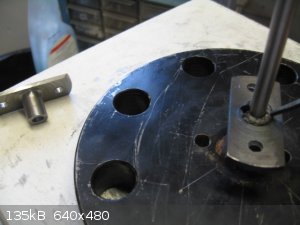
installing ptfe packing rings
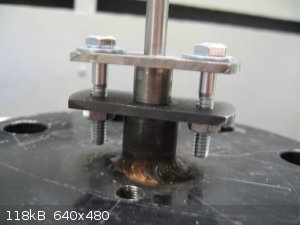
gland with 4 rings and gland follower
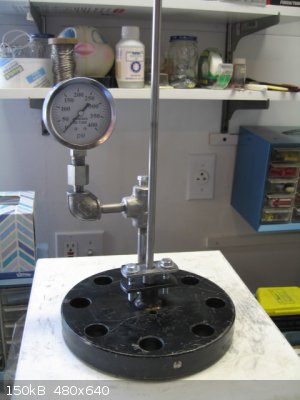
flange assembly
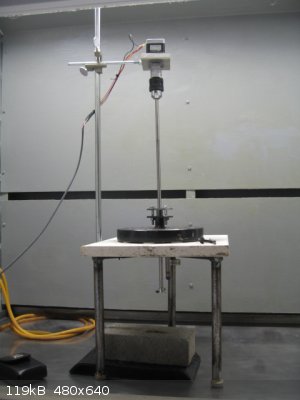
testing mode for the stirrer
[Edited on 14-6-2017 by Magpie]
The single most important condition for a successful synthesis is good mixing - Nicodem
|
|
|
Magpie
lab constructor
    
Posts: 5939
Registered: 1-11-2003
Location: USA
Member Is Offline
Mood: Chemistry: the subtle science.
|
|
I tested the autoclave packing gland with CO2 (est. pressure 900 psig). The gland sealed well with the shaft turning. However, an unanticipated
problem occurred: the internal gas pressure blew the shaft straight up and out hitting the ceiling of the hood. It then bounced off the floor of the
hood then slapped me on the arm. This did not hurt much but left a 2" bruise.
I have a fix for this as shown in the picture below. The calculated force on a 5/16" diameter shaft is 76 lbs for a 1000 psig internal gas pressure.
Using 16 bricks I constructed a restraint for the shaft/motor. I'll test again tomorrow.
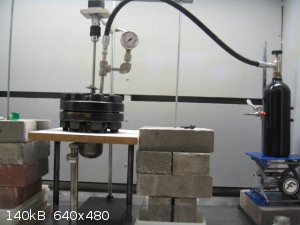
[Edited on 6-7-2017 by Magpie]
The single most important condition for a successful synthesis is good mixing - Nicodem
|
|
|
JJay
International Hazard
    
Posts: 3440
Registered: 15-10-2015
Member Is Offline
|
|
Wow, that sounds pretty scary. An autoclave like that is only a dream to most hobbyists.
|
|
|
| Pages:
1
2 |